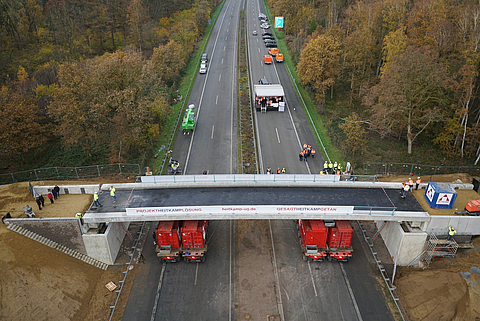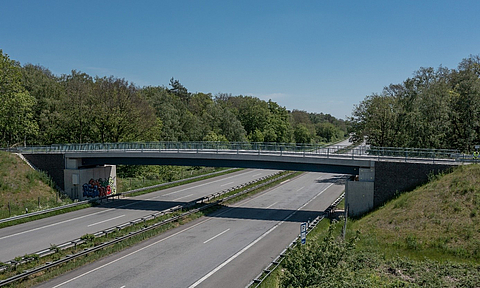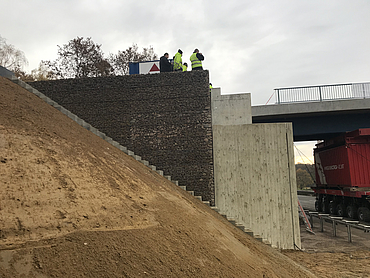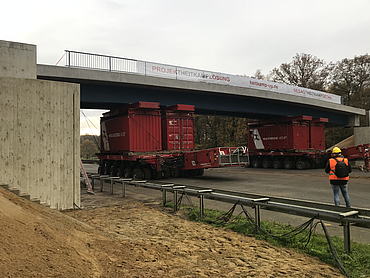
Construction of a geogrid-reinforced bridge A3
Project information
Construction project
Replacement bridge over the A3 motorway Stokkumer StraßeCustomer
Road construction authority of North Rhine-WestphaliaConstruction
Heitkamp Erd- und Straßenbau GmbH, HerneLocation
Elten , DEPlaning
Thomas & Bökamp Ingenieurgesellschaft mbH, Münster; IBH-Herold & Partner Ingenieure Part mbB, Weimar-Legefeld; HUESKER Synthetic GmbH, GescherConstruction time
September to November 2019Products used
Project details


Project description
As part of a pilot project on the A3 federal motorway near the Dutch border (north of Emmerich am Rhein, Germany), the Stokkumer Straße bridge, a flyover for a farm track over the motorway, was replaced. The reason for the replacement construction was the low load-bearing capacity of the old overpass structure which dated from 1961. The dimensions and location of the new bridge were to remain unchanged during the replacement and no centre support was planned for the new structure either. The explicit aim of the pilot project was to significantly reduce the construction time by using modern technologies.
Solution
A single-span composite superstructure with two tightly welded steel boxes and in-situ concrete additions was chosen as the new replacement structure. The special feature of the construction is the abutments made of geosynthetic-reinforced soil (GRS construction method with Fortrac geogrids). At the time of execution (September to November 2019), this was a construction method that was not yet regulated in Germany. This meant that advance approval had to be obtained. The measure was also accompanied by an extensive measurement programme to investigate the deformation behaviour under horizontal loads and to evaluate the load-bearing behaviour of the earth bodies. The extensive measurement programme was observed by experts from the federal government and the state of North Rhine-Westphalia
Following the dismantling of the existing bridge, the abutments were constructed as a GRS structure with superimposed reinforced concrete beams, chamber walls and bearing bases in in-situ concrete. Biaxial Fortrac MDT geogrids (material: PVA) with a tensile strength of 400/400 kN/m were used. The highly alkali-resistant material enables the use of binder-stabilised soils, among other things. Special challenges during the construction included the very confined space conditions, the high compaction requirements and the necessary installation of various measuring sensors in the GRS. The abutments were then clad with gabions and concrete slabs, which fulfil both a visual and a protective function. The design of the abutments as passive walls means that there is no earth pressure on the facing formwork.
The structure was built in a lateral position on an adjacent car park. The composite steel superstructure, which weighed approx. 400 tonnes, was then moved into place using a mobile platform (Self-Propelled Modular Transporter, SPMT) and placed on the abutments. The span of the new bridge was 36.8 metres, with a clear height of 4.70 metres. The total construction time for the parallel completion of the bridge abutments and the pre-assembled composite bridge was 80 days. Full closures of the A3 motorway were only necessary on two weekends.
Advantages
- Simple and safe construction: complex reinforcement and concreting work can be reduced to a minimum thanks to the GRS construction method
- Simple installation principle on a small footprint
- Simple realisation with standard earthworks equipment
- Fast and cost-effective construction method: Significantly shorter blocking and construction times compared to conventional solutions
- Environmentally friendly and resource-saving construction method: The GRS construction saves significantly on CO2 emissions by using soil instead of concrete and by reducing transport volumes
- Architecturally appealing and safe in the long term
Further information





